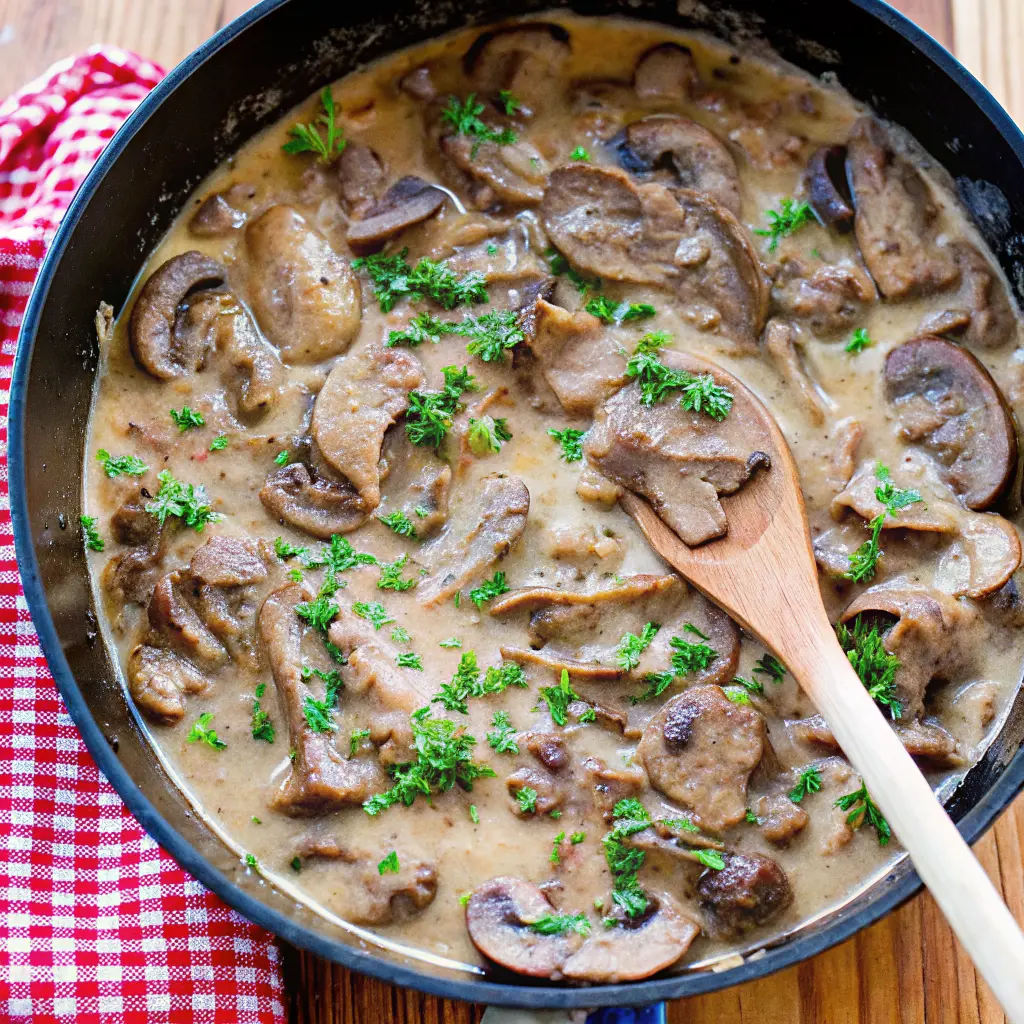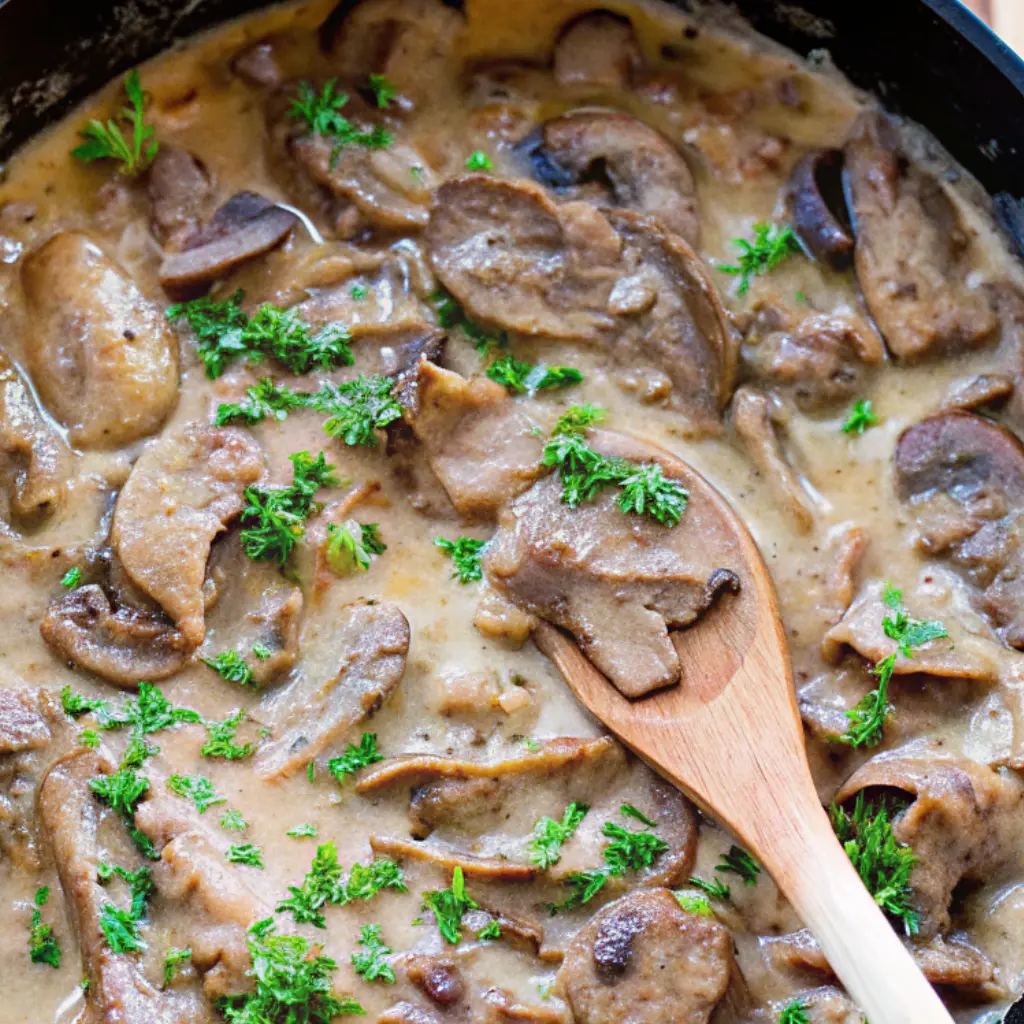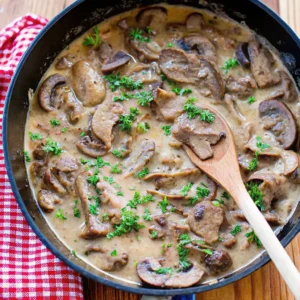There’s a quiet sort of magic in recipes that come from unexpected places. My beef stroganoff journey didn’t begin with a handwritten card from my grandmother or a fancy dinner in some restaurant—it began in the middle of a snowstorm, with a broken heater and a half-stocked fridge. I was newly married, far from home, and desperately trying to cook something comforting with what I had. The power flickered every few minutes, and I remember standing over the stove with a flashlight tucked under my chin, browning beef in my one decent skillet. I had no sour cream, no mushrooms—just onions, broth, and a sliver of hope. What came together that night wasn’t traditional, but it was hearty, rich, and exactly what we needed. Since then, stroganoff has become a comfort dish in our home, and over the years, I’ve fine-tuned it into something truly special—still simple, but full of soul.

Why You’ll Love This Recipe:
- Hearty and satisfying, perfect for cozy nights
- Uses simple pantry ingredients
- Ready in under an hour
- Family-friendly and customizable
- Delicious as leftovers—maybe even better the next day
Ingredients You’ll Need:
Beef: I usually go with sirloin or boneless ribeye, sliced thin against the grain for tenderness. Stew meat can work too, but give it more time to soften. I’ve even used leftover roast in a pinch—it adds a deeper flavor that’s hard to beat.
Onions: One large yellow onion, sliced thin. Don’t rush the sauté—they need time to mellow and sweeten.
Garlic: Just a couple cloves, minced. I’ve learned that garlic burns fast, so I always add it after the onions are translucent, never before.
Mushrooms: Cremini are my favorite—they hold their shape and flavor—but white button mushrooms will do just fine. If you’re not a mushroom fan, you can skip them, but they do add that earthy depth.
Butter and Olive Oil: A mix of both gives better control over browning without burning the butter.
Beef Broth: Homemade is a treat, but store-bought works. I usually go for low-sodium so I can season everything myself.
Dijon Mustard: Just a small spoonful. It sounds odd, but it sharpens the flavors beautifully without making the dish taste mustardy.
Worcestershire Sauce: Another quiet hero—it deepens the sauce and adds a bit of umami. I’ve forgotten it once or twice and missed it every time.
Sour Cream: Full-fat is best. It gives the sauce that signature tang and richness. I warm it to room temp before stirring it in—cold sour cream can curdle if added directly to hot liquid.
Flour: Just a tablespoon or so to thicken the sauce slightly. You can skip it if you prefer a thinner consistency.
Egg Noodles: Classic and cozy, but rice, mashed potatoes, or even crusty bread work well too.
Salt and Pepper: Always to taste—and never forget to taste.
How to Make It (Step-by-Step Instructions):
Start by slicing your beef thinly, against the grain. I like to pop it in the freezer for about 20 minutes before cutting—it firms up just enough to slice cleanly. Season it well with salt and pepper. In a large skillet or Dutch oven, heat a tablespoon of olive oil and a knob of butter over medium-high. Brown the beef in batches—don’t crowd the pan. If you do, it’ll steam instead of sear, and that caramelization on the meat makes all the difference. Once browned, remove it and set aside.
In the same pan, lower the heat to medium. Add a little more butter if needed, then sauté the onions until they’re soft and golden. This part can’t be rushed; I usually give them 10–12 minutes. Add the garlic and cook for just another minute, until fragrant. Stir in the mushrooms and cook until they release their moisture and begin to brown—again, patience here rewards you later.
Sprinkle in the flour and stir until everything’s coated. This helps thicken the sauce without lumps. Pour in the beef broth slowly, scraping up the browned bits from the bottom of the pan. Stir in the Dijon and Worcestershire. Bring everything to a gentle simmer, then return the beef (and any juices) to the pan. Let it simmer on low for 10–15 minutes, just enough to bring all the flavors together.
Turn off the heat and let the pan cool slightly for a couple minutes before adding the sour cream. This keeps it from curdling. Stir gently until the sauce turns creamy and luscious. Taste and adjust salt and pepper one last time. Serve it hot over cooked egg noodles—or whatever your heart calls for.

Expert Tips for the Best Results:
The key to a great stroganoff is timing and temperature. Don’t rush the browning process—those little golden bits at the bottom of the pan are pure flavor. And when it comes to the sour cream, always temper it by letting the pan cool down a touch first. I’ve curdled more than one batch by being impatient. If you want an even silkier sauce, you can whisk a bit of warm broth into the sour cream before adding it to the pan. It blends like a dream. Lastly, give the dish a few minutes to rest before serving—just like soup or stew, it deepens in flavor as it sits.
Variations & Substitutions:
Over the years, I’ve had to get creative more than once. Greek yogurt works in place of sour cream, though it’s a bit tangier and less rich—good in a pinch. I’ve also made a dairy-free version using coconut cream and a splash of white wine, which gave it a surprising depth. When I didn’t have fresh mushrooms, a spoonful of mushroom powder added that same umami note. And once, in a moment of desperation, I used ground beef instead of sliced steak—it wasn’t traditional, but with all the right seasonings, it turned out hearty and comforting just the same.
Serving Suggestions:
I usually serve stroganoff over wide egg noodles, with a sprinkle of parsley if I remember. But it’s just as lovely ladled over mashed potatoes on a cold night, or even on toasted sourdough as an open-faced sandwich. I like to serve it with something green on the side—roasted broccoli or a sharp little salad with vinegar and shallots. It makes for a balanced plate and cuts through the richness just enough.
Storage & Reheating Instructions:
I keep leftovers in a sealed container in the fridge for up to three days. The sauce thickens as it sits, but that’s not a bad thing. I reheat it gently on the stove over low heat, adding a splash of broth or water to loosen it up. Microwaving works too—just go slow and stir often to avoid overheating the sauce. The noodles tend to absorb a bit more liquid, but the flavor deepens overnight, and that’s always a bonus in my book.
Recipe FAQs (Answered by Clara):
Can I make this ahead of time?
You sure can. I often prepare it in the morning, cover it tightly, and pop it in the fridge. It actually tastes better after resting.
What kind of beef works best?
Sirloin is my go-to—it’s tender, easy to slice, and doesn’t need long cooking. But I’ve used chuck roast, flank steak, even leftover pot roast. Just slice thin and adjust your simmer time.
Is there a way to make it lighter?
Absolutely. Use Greek yogurt instead of sour cream, and swap the noodles for cauliflower rice or steamed green beans. It won’t be quite the same, but it’ll still warm you up just right.
Can I freeze beef stroganoff?
Yes, though I recommend freezing the sauce and beef without the noodles. Sour cream can separate when frozen, but I’ve found that reheating slowly and whisking helps it come back together nicely.
What if I don’t have Dijon mustard?
You can skip it, but a tiny splash of vinegar or a squeeze of lemon can help brighten the flavors in its place.

If you’re looking for a dish that warms both the belly and the soul, this beef stroganoff might just be it. It’s one of those recipes that carries stories with it—quiet, comforting, and full of little lessons learned along the way. I hope you make it your own, tweak it, share it, and return to it when you need a little home on a plate. And if you do try it, I’d love to hear how it turned out for you—leave a comment, send a photo, or just keep cooking with heart.
Nutrition Information (Approximate per serving):
- Calories: 475
- Protein: 28g
- Fat: 28g
- Carbohydrates: 29g
- Fiber: 2g
- Sugar: 4g
- Sodium: 580mg

Beef Stroganoff
Ingredients
- 1 lb 450g beef sirloin or tenderloin, thinly sliced into strips
- Salt and black pepper to taste
- 2 tablespoons olive oil or butter
- 1 small onion finely chopped
- 2 cloves garlic minced
- 8 oz 225g mushrooms, sliced
- 1 tablespoon flour
- 1 cup beef broth
- 1 tablespoon Dijon mustard
- ½ cup sour cream
- 1 tablespoon Worcestershire sauce
- Fresh parsley chopped (for garnish)
- Cooked egg noodles mashed potatoes, or rice (for serving)
Instructions
- Sear beef: Season the beef strips with salt and pepper. In a large skillet over medium-high heat, heat oil. Sear beef in batches until browned. Remove and set aside.
- Sauté veggies: In the same skillet, add a bit more oil if needed. Sauté onions for 2–3 minutes until soft. Add garlic and mushrooms, cooking until the mushrooms are browned and liquid has mostly evaporated.
- Make the sauce: Sprinkle flour over the vegetables and stir for 1 minute. Slowly pour in the beef broth, stirring constantly. Add Worcestershire sauce and mustard. Simmer until the sauce thickens slightly, about 5 minutes.
- Add sour cream: Lower heat and stir in sour cream until well combined. Do not boil to prevent curdling.
- Return beef: Add the seared beef back into the skillet. Simmer gently for 3–5 minutes until heated through and the sauce is creamy.
- Serve: Garnish with fresh parsley and serve over egg noodles, mashed potatoes, or rice.
Notes
- Beef tips: Use tender cuts like sirloin or tenderloin. Avoid overcooking to keep the beef tender.
- Sour cream tip: Let sour cream come to room temperature before adding to the hot pan to prevent curdling.
- Make-ahead: The sauce can be made ahead. Add beef just before serving for best texture.
- Mushroom swap: Try cremini, button, or even portobello mushrooms for added flavor.

